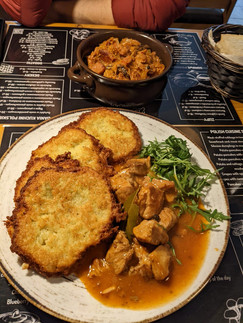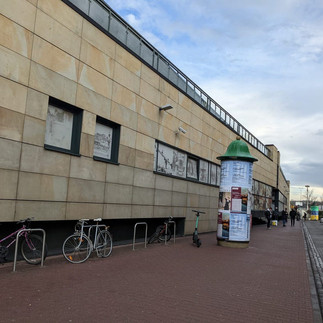Polish food, pinball and history in Krakow
- David Robinson
- May 13, 2022
- 7 min read
In Krakow we had rented a modern small apartment on Airbnb on the edge of the kazimerza? Area of Krakow. It was well designed with a small kitchen area with TV and bar table space, really comfortable bed and stunning bathroom. After such a terribly wet drive we were very happy to be somewhere so nice and to have a lovely hot shower to warm up. We settled ourselves in unpacking as we were there for a few nights, always a good feeling when you are on the road. We were starving at this point so we headed out for a wander and found a pierogi shop(?) to try Poland's answer to dumplings. They were steamed and we went for meat and then bacon and potato ones. Both are equally delicious and very filling.
We walked it off by heading past the old town to find the bus station as we would need it to make our way to Auschwitz in a few days time. We also headed to a local Carrefour supermarket- which was massive, to buy some groceries to make meals whilst we had facilities to do so. The rest of the day we were so exhausted from the terrible journey we ended up just chilling out at the apartment doing some washing, cooking dinner and watching a whole series of 'Is it cake?' which we enjoyed way more than we should have. Sometimes you just need to mindlessly zone out to recover.
After a restorative night's sleep, a good breakfast and coffee we went out to actually explore Krakow. We walked to the old town along the Planty park to the Barbican before entering the old town through the old gates. It had lovely old architecture, as well as standard tourist shops and restaurants. There were also a lot of people offering tours or trying to tempt you into restaurants as well as lots of old ladies selling oberans krakowskis??- ringed breads. In the main square by the town hall there were stalls selling Easter flower decorations and a gathering in support of Ukraine. We carried on mooching through the Old Town and wandered along to Wawel castle. You can actually explore the grounds for free so we did this, looking at the impressive castle and church inside as well as the views out over the Vistula river.
Now getting very hungry we headed to a local restaurant called Bar Smak. This place was only small but did a range of Polish dishes and got very busy. We ended up trying Bigos- a sauerkraut and meat stew as well as potato pancakes with a different stew. Very tasty and warming- polish food is hearty but delicious. We took the long way back to our apartment walking along the Vistula river boulevards, past the castle at the bottom so we could see the dragon statue. Apparently it used to 'breathe fire' too but a pigeon got caught in the flames and scared some children so it doesn't any more. We also wandered through the Jewish kazimerza district which now is one of the trendiest areas for cafes, bars and restaurants. There were also lots of various street food stalls dotted about on corners. After lots of walking we went to chill out at the flat, sort out some blogs and cook dinner.
In the evening we headed out again through the kazimerza area- where it was busy for a Wednesday evening and had a really cool vibe. Instead though we went to the pinball museum. This underground museum is full of old and new pinball machines and video games. You can pay for an hour or all day play and then play on all of the machines. I am not a gamer but pinball is fun, as anyone can give it ago. I slowly worked my way around the machines as I died very quickly but it was a lot of fun and a different way to spend an evening. We also had a couple of beers as why not and we were aware the next day was going to be heavy.
We knew if we were coming to Krakow that we needed to visit Aushwitz. We knew it would be a heavy day but that it is important to visit such historical locations so that these events and atrocities can be remembered. Aushwitz is actually made up of 2 sites- Aushwitz 1 and Birkenau- which was an extension of the concentration camp and held more gas chambers. They are both also about 1 and a half hours from Krakow, near Osciewm? There are lots of tour companies that run from Krakow where they will collect you from your accomodation in shuttle buses and arrange the Auschwitz tickets for you. Through reading other blogs though I had found that you could take public transport to the museum and also buy tickets online. I costed both up and managed to save ourselves about 30 pounds by doing it independently. It was also relatively painless. Buses run from the main MDA? bus station (behind the train station). Could can buy tickets for various companies there but I booked ours online with Lajonik? They run regular coaches throughout the day that stop right outside Aushwitz museum. (You can find the timetable and link to buy them here…) I just made sure to book ones that matched around the time of the tour. You need to book tickets as an individual visitor and book onto a tour in the right language with an Aushwitz educator. Tours run at certain times for languages and it is about 3 hours in total so you need to book buses around this. If not you can also just buy tickets on the bus when you get there/ when you want to return.
We arrived at the G1 stand at the bus station, showed our bus tickets when the bus pulled up and then were on a coach for a very smooth but very hot journey through the polish countryside and toll roads. Very easy. When we arrived at Aushwitz we showed our individual visitors tickets, had to get our bags checked through security and then collected our headsets through which we would hear our guide. First we sat through a 10 minute film giving a brief history of Aushwitz before meeting our guide.
Over the next few hours our guide lead us around Aushwitz 1 providing us with information about the site, how specific areas were used as well as leading us through some of the exhibitions put up in the actual camp buildings- photographs taken of the camp as well as collections of personal items like luggage, shoes, hair brushes, pots/pans that were only a small proportion of the amounnt taken from people are gathered together to highlight how many people came to this camp and were murdered. It also highlighted the fact that people came initially on trains in awful conditions to be told that they were starting a new life where all their wordly possessions were then taken away from them and they were told they were having a ‘shower’ before entering gas chambers to be exterminated. A large percentage of these people were women and children, who were deemed unable to be useful for work. Seeing the display of childrens shoes, sent shivers down my spine. What surprised me most was the extent of places that people were sent from to the camp. Aushwitz was in the centre of Europe so the Nazis were able to ship thousands of Jews and other nationalities here to be either murdered straight away in gas chambers or sent to complete manual labour whilst being torutured and enduring horrific conditions and illness. People were sent from as far as Oslo and Greece. A glass cabinet spanning an entire room full of human hair was particularly harrowing. This was cut off those that went into gas chambers and then used as a resource to make fabric. With it only being a small percentage of the hair that would have been taken it was particularly effective at highlighting the extent of the loss of human life. We were also able to walk through the Aushwitz 1 original gas chamber, which was turned into a storage room after the Birkenau site was made. It was as eery as it should be for how many people died in there and is part of the tour that is silent, as it should be to be able to appropriately consider what you are walking through.
After a short break we had to hop on the free shuttle bus to Birkenau. These run every 10 minutes and it takes about 10 minutes to get there. This part of the tour lasted about an hour and we met our guide there. The Birkenau site was made as an extension to the Aushwitz camp so that they could hold a lot more people and also exterminate a lot more. There were 4 gas chambers on this site that could kill nearly 2000 people in one go. The thought of that is still uncomprehensible. The sheer scale of the site- with ruins of camp shelters running as far as your eyes can see just puts into perspective how vast this place was. We also had a chance to visit the death shelter where females that had run out of ‘usefulness’ or were too sick to work were put. It highlighted the squalid conditions that these poor people suffered through before being taken to the gas chambers. It was a truely worthwhile visit, and hard to put into words. It is still difficult to comprehend what happened there even after visitng, as it is just something hard to believe humanity can do to each other. Emotionally drained we had a very quiet lunch whilst waiting for our bus back to Krakow, and then watched the world go by for a couple of hours whilst we tried to process what we had just seen and learnt about. After a very heavy day we had a quiet evening.
We are heading to a guest house halfway to Warsaw after this to break up the journey.
Thanks
Alex



















































































Comments